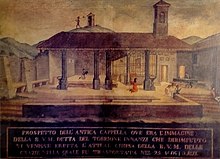Santa Maria delle Grazie, Crema
The sanctuary of the Madonna delle Grazie (Cremish dialect: santüare dale Grasie) is a place of Marian worship located in Crema.
[2] Near the present church, inside the Torrione del Miliato (from the convent of the Humiliati), an image depicting a Madonna and Child had been painted by a certain Giovanni da Caravaggio during the 15th century.
[5] The location, however, was not very appropriate: the risk of war forced the civil authorities to continuously maintain the city's defensive apparatus with reinforcements and modernizations, a task that endangered the existence of the votive icon.
Military experts repeatedly warned the ecclesiastical authorities that they might have to demolish the portico to change the place where the sacred image stood.
[6] At the end of the 16th century the ancient church of Saints Philip and James, annexed to the former convent of the Humiliati (the order had been suppressed by Pope Pius V in 1567), had been demolished.
[8] In 1606 the bell tower was completed and in 1609 the church was consecrated;[8] in 1613 the sacred image was transferred there in the presence of religious authorities (led by the Bishop of Crema, Monsignor Gian Giacomo Diedo), civil authorities (the Podestà and Captain Pietro Capello and the Superintendent Pietro Bondemier), the Superintendents and the faithful.
Two days later, on September 11, the bishop of Mantua, Monsignor Giuseppe Melchiorre Sarto, the future Pope Pius X, celebrated a solemn pontifical mass there.
As mentioned above, the church stands on the site where another place of worship dedicated to Saints Philip and James and run by the Humiliati friars once stood, and was demolished in 1583.
The scene of the Flight into Egypt is on the right wall: it shows a pause in the journey of the Holy Family, with the Madonna in traveling clothes riding a donkey and in the act of handing the Child to Joseph.
The family is surrounded by a group of eight little angels: three are holding the reins, one is spreading a cloak on the ground, one is reaching out to help the Virgin descend from the donkey, and three are flying in the air.
[21][22] This is located on the barrel vault and is a highly illusionistic scene: above the real entablature, Barbelli painted a balcony in perfect perspective with angels and cherubs sitting on the balustrade.
[23] The prevailing light comes from the counter-façade, so it has been hypothesized that it was the painter himself who wanted the large window enlarged precisely for this painting.
[24] The altar and the balustrade surrounding the presbytery are in neoclassical style and were installed in 1824; the materials used are white granite and red Verona marble.
[25] In the altarpiece, between two columns, is placed the venerated image, transferred from the tower of the Venetian walls; the painting is of uncertain attribution, according to tradition, it was made by a certain Giovanni da Caravaggio, but it was also retouched by Tomaso Pombioli (who revitalized the color and worked on the angels holding the crown) and perhaps by Barbelli himself, who could have added the three winged cherubs on the top of the painting.
[26] The two columns support an entablature on which two angels are seated, holding an epigraph with the inscription:[25] The altarpiece is flanked by two statues in Carrara marble, representing Mary Magdalene and St. John the Apostle, signed by Andrea Fantoni in 1716 and coming from the suppressed church of Santa Caterina.






